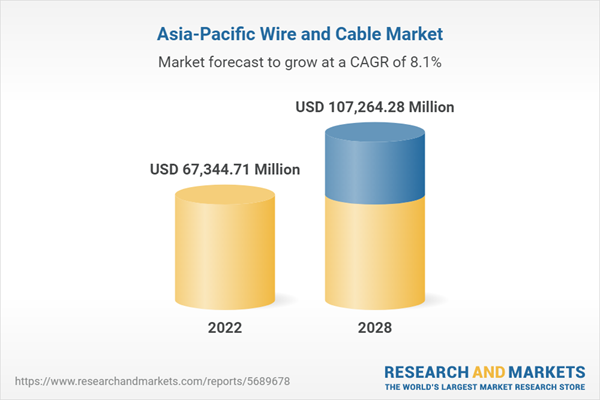The wire and cable market in APAC is expected to grow from US$ 67,344.71 million in 2022 to US$ 1,07,264.28 million by 2028. It is estimated to grow at a CAGR of 8.1% from 2022 to 2028.
After years of digitization, industries are now turning toward it. Aside from the legacy systems, all aspects of manufacturing, including the products, machines, and processes, are influenced by technology. The industrial internet of things (IIoT) or smart manufacturing is a result of the fourth industrial revolution. The wire and cable sector appears well-prepared to participate in the fourth industrial revolution. The sector is evolving quickly. Market and consumer demands have changed, and pressure on policies and worldwide competition has grown. Thus, the industry must introduce innovative products to stay competitive. The new industrial revolution brings two significant developments in the wire and cable sector. The demand for products from the businesses investing in notable innovation and awareness campaigns will soon be driven by the other key reason, which is driven by the other when the first is driven by the technology adaption point of view. More advanced, secure, commercial/industry-grade wires and cables will be needed for specialized equipment and goods. Further, although a few pieces of equipment are used in homes, wire and cable goods will still be considered under the commercial category; they must adhere to certain criteria set by the industry or legislators. The residential wires and cable market is expected to experience a new demand due to the growing use of IoT devices and equipment. There will be a desire for certain brands and variations of commercial-grade merchandise linked to well-liked IoT equipment. Thus, growth in Industry 4.0 will boost the demand for wire and cable.
After years of digitization, industries are now turning toward it. Aside from the legacy systems, all aspects of manufacturing, including the products, machines, and processes, are influenced by technology. The industrial internet of things (IIoT) or smart manufacturing is a result of the fourth industrial revolution. The wire and cable sector appears well-prepared to participate in the fourth industrial revolution. The sector is evolving quickly. Market and consumer demands have changed, and pressure on policies and worldwide competition has grown. Thus, the industry must introduce innovative products to stay competitive. The new industrial revolution brings two significant developments in the wire and cable sector. The demand for products from the businesses investing in notable innovation and awareness campaigns will soon be driven by the other key reason, which is driven by the other when the first is driven by the technology adaption point of view. More advanced, secure, commercial/industry-grade wires and cables will be needed for specialized equipment and goods. Further, although a few pieces of equipment are used in homes, wire and cable goods will still be considered under the commercial category; they must adhere to certain criteria set by the industry or legislators. The residential wires and cable market is expected to experience a new demand due to the growing use of IoT devices and equipment. There will be a desire for certain brands and variations of commercial-grade merchandise linked to well-liked IoT equipment. Thus, growth in Industry 4.0 will boost the demand for wire and cable.
Market Overview
China, India, South Korea, Japan, and Australia are among the key economies in Asia Pacific. The region's economy is performing well due to numerous technological and infrastructural developments. The urbanization of countries like Japan, India, China, and South Korea is primarily driving market expansion. A further cause for the product market's expansion in the upcoming time zone is still projected to be the development of construction infrastructure, which will also provide potential investors with new prospects for expansion in the entire product market. Sectors including medical, aerospace, and defense are moving toward new infrastructure and development as a result of increased expenditures in the smart grid and more power for residential and industrial sectors. This will create new opportunities for the product market to pursue growth.APAC Wire and Cable Market Segmentation
The APAC wire and cable market is segmented into type, end use industry, and country. Based on type, the market is segmented into cable, wire, and push-pull controls. The wire segment registered the largest market share in 2022.- Based on end use industry, the APAC wire and cable market is segmented into aircraft, transportation, medical, marine, and construction. The transportation segment registered the largest market share in 2022.
- Based on country, the market is segmented into Australia, China, India, Japan, South Korea, and rest of APAC. China dominated the market share in 2022.
Table of Contents
1. Introduction
3. Research Methodology
4. APAC Wire and Cable Market Landscape
5. APAC Wire and Cable Market - Key Industry Dynamics
6. Wire and Cable Market - APAC Market Analysis
7. APAC Wire and Cable Market Analysis - By Type
8. APAC Wire and Cable Market Analysis - By End Use Industry
9. APAC Wire and Cable Market - Country Analysis
10. Industry Landscape
11. Company Profiles
12. Appendix
List of Tables
List of Figures
Companies Mentioned
- ASK Automotive Pvt. Ltd.
- Carl Stahl Sava Industries
- Guangdong Jinlianyu Cable industrial Co., Ltd
- Henan Sanheng Industrial Co., Ltd
- RR Kabel
Table Information
| Report Attribute | Details |
|---|---|
| No. of Pages | 105 |
| Published | October 2022 |
| Forecast Period | 2022 - 2028 |
| Estimated Market Value ( USD | $ 67344.71 Million |
| Forecasted Market Value ( USD | $ 107264.28 Million |
| Compound Annual Growth Rate | 8.1% |
| Regions Covered | Asia Pacific |
| No. of Companies Mentioned | 5 |









